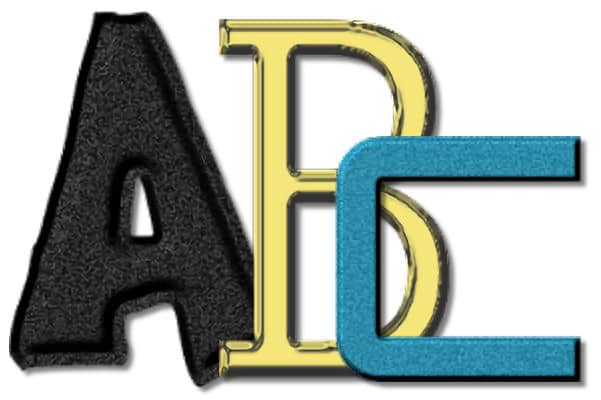Build-A-Kit – Alpha
Alphas are often welcome additions to a kit especially if the designer makes them in a way that would otherwise be challenging for the user.
HOW MANY?
One alpha is often enough for a kit, but they can be so easy to make that you will likely be tempted to create more than one (beware, it can be addictive). If you want to create more than one, make sure they are really different and not just different colors of the same thing. So, use different fonts, different textures, different effects, different backgrounds, etc.
HOW TO CREATE ALPHA?
Typically, you can provide a whole alphabet on a single sheet that the user will have to cut out as needed. Several designers do that. And even if you don’t want to offer the alpha on a single sheet, it might be how you will create it in the first place.
Start with a large blank canvas (3600×3600 pixels is usually enough) and write all the letters of the alphabet, making sure they are well-spaced out. You might need to adjust the kerning and the leading for that. Set a size of at least 400 pixels in height. That will be a bit over one inch high for the individual characters.
- Choose a font: if you want to sell your kits, make sure that the font you choose allows “Commercial Use”. Apply that font to all the characters.
- Choose the color/pattern: you can use something from the papers you created but you can also choose a solid color from the palette.
- Convert to a raster layer: this will allow you to add various effects, like texture, bevels, additional layers, etc.
- Separate the individual characters: although this is not mandatory, the users will love you as it saves them work and time.
- Save the individual files.
ANOTHER METHOD
Sometimes, you want to have an alphabet to appear on a base, like a piece of paper, a tag, or other media. If that is what you want, the approach will be slightly different.
- Create the base however you want on a canvas that is at least as large as the largest character (often, uppercase M or W).
- Add the first character on your base.
- Convert to raster and apply the various effects you want (bevel, texture, shadow, etc.)
- Once you are happy, Copy Merged (Ctrl-Shift-C), and paste as a new image (Ctrl-Shift-V). This will give you one file that you can save.
- Close that image.
- Back to the image where you had the base, use your history palette (F3), and undo all the steps until you have the character in vector format.
- Replace the previous character by the next one and repeat the steps you took to create your letter.
- Copy Merge and continue like that one character at a time.
WHAT TO INCLUDE?
Typically, alphas will include at least the uppercase characters. Lowercase letters are nice to have, but obviously will require more work. If you can include some digits, it will allow the user to add dates. A few punctuation symbols will be useful, like apostrophe, hyphen, period, exclamation mark, question mark, and such.
If you are so inclined, you can also add some accented characters especially if you are familiar with a language that has some.
If you want more ideas, check out these two Master classes on the topic:
Alpha-Making
Alpha-Making – 2
If you are interested, there is also a script, from Suz Shook, to help out. It is called MakingAlpha It is a little bit of work and requires you to record a script to create the individual letters, but it might be worth it, if you happen to want or need alphas in the future. I should add it in the store, but in the meantime, you can get it HERE.





